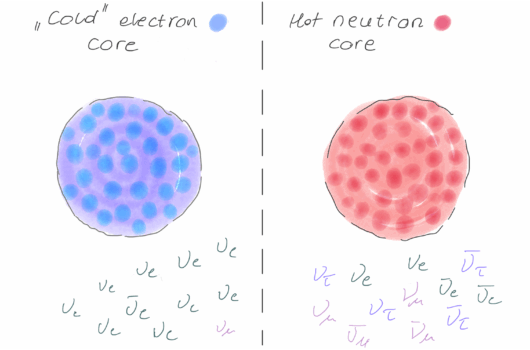Long-lived neutron-star remnants from asymmetric binary neutron star mergers: element formation, kilonova signals and gravitational waves
Long-lived neutron-star remnants from asymmetric binary neutron star mergers: element formation, kilonova signals and gravitational waves
View
Abstract
We present 3D general-relativistic neutrino-radiation hydrodynamics simulations of two asymmetric binary neutron star mergers producing long-lived neutron stars remnants and spanning a fraction of their cooling time scale. The mergers are characterized by significant tidal disruption with neutron rich material forming a massive disc around the remnant. The latter develops one-armed dynamics that is imprinted in the emitted kilo-Hertz gravitational waves. Angular momentum transport to the disc is initially driven by spiral-density waves and enhanced by turbulent viscosity and neutrino heating on longer timescales. The mass outflows are composed by neutron-rich dynamical ejecta of mass ![]() followed by a persistent spiral-wave/neutrino-driven wind of
followed by a persistent spiral-wave/neutrino-driven wind of ![]() with material spanning a wide range of electron fractions,
with material spanning a wide range of electron fractions, ![]() . Dynamical ejecta (winds) have fast velocity tails up to
. Dynamical ejecta (winds) have fast velocity tails up to ![]() (
(![]() ) c. The outflows are further evolved to days timescale using 2D ray-by-ray radiation-hydrodynamics simulations that include an online nuclear network. We find complete
) c. The outflows are further evolved to days timescale using 2D ray-by-ray radiation-hydrodynamics simulations that include an online nuclear network. We find complete ![]() -process yields and identify the production of
-process yields and identify the production of ![]() Ni and the subsequent decay chain to
Ni and the subsequent decay chain to ![]() Co and
Co and ![]() Fe. Synthetic kilonova light curves predict an extended (near-) infrared peak a few days postmerger originating from
Fe. Synthetic kilonova light curves predict an extended (near-) infrared peak a few days postmerger originating from ![]() -process in the neutron-rich/high-opacity ejecta and UV/optical peaks at a few hours (ten minutes) postmerger originating from weak
-process in the neutron-rich/high-opacity ejecta and UV/optical peaks at a few hours (ten minutes) postmerger originating from weak ![]() -process (free-neutron decay) in the faster ejecta components. Additionally, the fast tail of tidal origin generates kilonova afterglows potentially detectable in radio and X band on a few to ten years time scale. Quantitative effects originating from the tidal disruption merger dynamics are reflected in the multimessenger emissions.
-process (free-neutron decay) in the faster ejecta components. Additionally, the fast tail of tidal origin generates kilonova afterglows potentially detectable in radio and X band on a few to ten years time scale. Quantitative effects originating from the tidal disruption merger dynamics are reflected in the multimessenger emissions.




